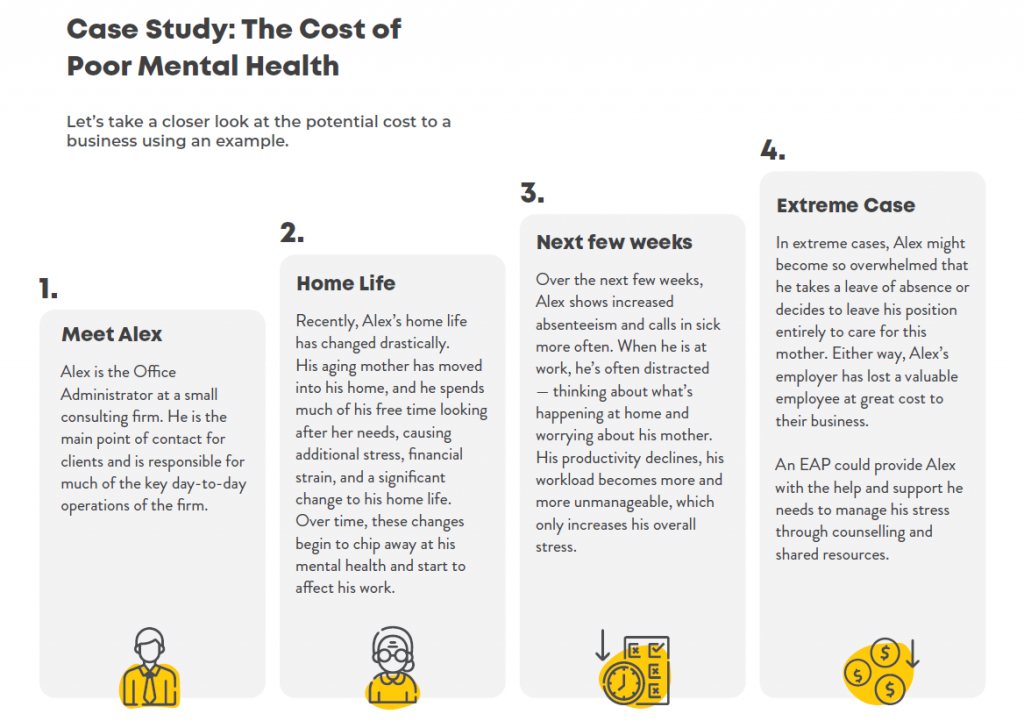5 Practical Tips for Managing Employee Mental Health
By: Benefits by Design | Sunday May 21, 2017
Updated : Monday December 14, 2020
As the stigma around talking about mental health issues begins to disintegrate (albeit, still too slowly), employers are seeing rising incidence rates of mental health issues in the workplace.
People are more comfortable than ever talking about what’s bothering them at home or at work, so employers can expect to see this trend continue.
Managing Employee Mental Health
Employers looking to keep employees happy, productive, and engaged, as well as reduce costs for their own business, should have mental health on their mind. Here are 5 practical tips for effectively manage and support employee’s mental health!
#1. Offer an Employee Assistance Program (EAP)
An Employee Assistance Program (EAP) provides employees with access to accredited professionals to help work through some of life’s challenges, such as elder or child care concerns, financial or marital troubles, or general stress related to any of the above.
An EAP provides real, timely support through a variety of sources, including in-person or over-the-phone counselling and resource sharing and recommendations from licensed professionals.
We’re not going to pretend that EAPs are the answer to the mental health crisis in Canada, but what we will say is that EAPs can be an effective way to help employees manage stress and address personal problems to improve productivity and performance at work.
#2. Offer Paid Personal Time Off
Life gets busy and stressful for everyone at some point, and sometimes employees just aren’t in the right head space for work and they need a mental break.
Offering paid personal time off provides employees with time off to focus on working through whatever is going on, or maybe just to provide that extra-long weekend so that they can fully relax and start back up again energized and ready for work.
This personal time off should be separate from any vacation time allotted to employees, which leads us into our next tip…
#3. Offer Vacation Time and Encourage its Use
Taking a break from work is important for employee’s overall mental health. Without it, employees run the risk of getting worn down and losing productivity and engagement, which are detrimental to employee morale, corporate culture, and ultimately your profits.
You need to do more than simply offer vacation time, though — you need to actively encourage employees to use it! There’s a few ways to do this, but one that we’ve found effective is providing a vacation incentive for using all of your vacation in the year. Employees who do so are entered to win $500 and a paid trip for two to anywhere in North America!
Since the implementation of the incentive program, vacation usage increased substantially across all teams at Benefits by Design!
#4. Implement Workplace Mental Health Programs
Happy, healthy employees are more productive, engaged in their work, and are more likely to report higher job satisfaction than unhappy ones.
Workplace mental health programs can incorporate some of the tips already mentioned here (such as an EAP), but also simpler awareness campaigns, such as those provided by the Canadian Mental Health Association (CMHA).
Not only do these programs offer real value through the sharing or resources and support, but they also work to keep mental health top of mind for employees through awareness.
#5. Ensure Resources are Accessible
One of the greatest barriers to utilization of benefits offerings is often a very simple one: employees don’t know where to go to access the programs or resources.
Ensure that you have a dedicated place for employees to access the help they need — whether that be the phone number to your EAP provider, or informational brochures and posters — and that they know where to go.
Food for Thought: Good or Bad, Employee Mental Health Has a Cost
Managing employee mental health is an important aspect of running a business. After all, employees are your most valuable resource, and no matter which way you slice, mental health has a cost — how much is up to you.
A “good” cost might be the cost to supply mental health resources or programs to employees or the cost in absenteeism of providing mental health days through personal time off. It costs money, but it’s for a good reason. The “bad” costs are a bit more involved (and far more costly).
We’ve already established that there is a connection between mental health and disability claims in a previous blog post (short version: mentally healthy employees go on disability far less frequently), so there’s a lot of time and money on the line for employers if they’re not doing all they can for their employees’ mental health.

Case Study: The Cost of Poor Mental Health
Let’s take a closer look at the potential cost to business using an example.
Meet Alex
Alex is the Office Administrator at a small consulting firm. He is the main point of contact for clients and is responsible for much of the key day-to-day operations of the firm.
Home Life
Recently, Alex’s home life has changed drastically. His aging mother has moved into his home, and he spends much of his free time looking after her needs, causing additional stress, financial strain and a significant changes to his home life. Over time, these changes begin to chip away at his mental health and start to affect his work.
Next Few Weeks
Over the next few weeks, Alex shows increased absenteeism and calls in sick more often. When he is at work, he’s often distracted – thinking about what’s happening at home and worrying about his mother. His productivity declines, his workload becomes more unmanageable, which only increases his overall stress.
Extreme Case
In extreme cases, Alex might become so overwhelmed that he takes a leave of absence or decides to leave his position entirely to care for his mother. Either way, Alex’s employer has lost a valuable employee at great cost to their business.
An EAP could provide Alex with the help and support he needs to manage his stress through counselling and shared resources.


